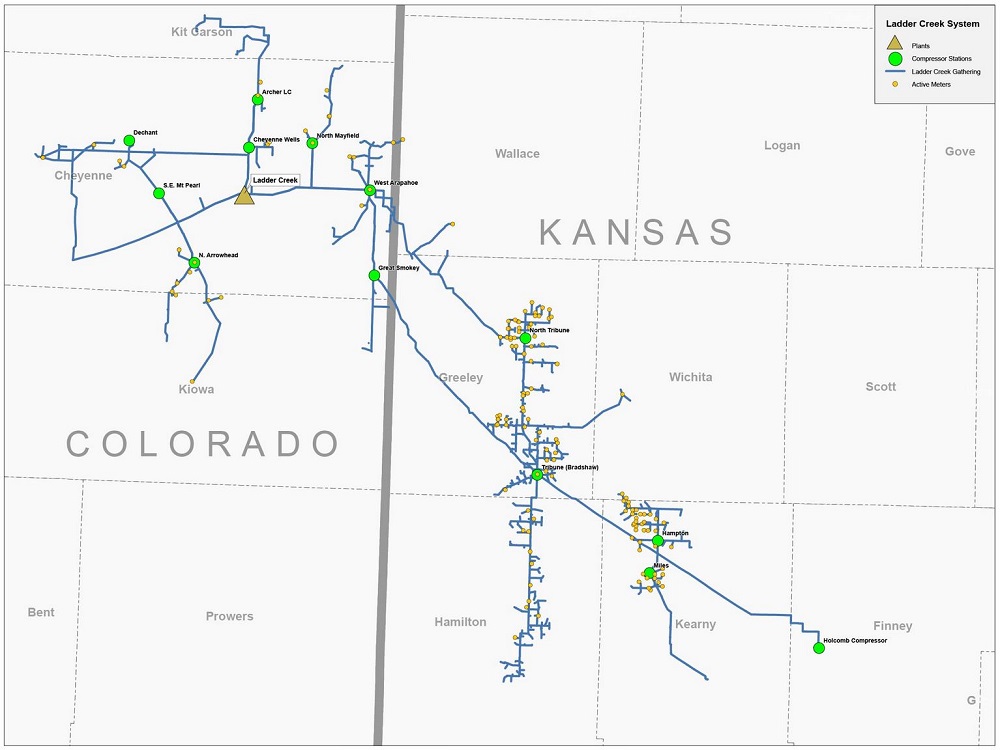Tumbleweed Acquires Ladder Creek Helium Plant, System from DCP
(P&GJ) — Newly established Tumbleweed Midstream announced it has acquired the Ladder Creek Helium Plant and its associated 730-mile gathering and distribution pipeline systems from DCP Midstream.
The plant, which separates helium from the natural gas stream and liquefies it for transport, serves producers operating in the Morrow, Mississippian, Spergen, Chester and Marmaton formations of eastern Colorado and western Kansas, where natural gas has average helium concentrations as high as 3%.
Current processing capacity at the Ladder Creek cryogenic processing plant is 40 million cubic feet of natural gas per day (MMcf/d), expandable to 50 MMcf/d. The plant has the capacity to extract and liquefy 1.5 MMcf/d of helium, with extraction and liquefaction to purity levels of 99.999 percent. The plant also produces NGLs and residue gas. NGLs are transported via pipeline to the DCP Wattenberg pipeline for transportation to Conway, Kansas, for fractionation. Residue gas is sent via pipeline to CIG Rockies or to regional producers for use as fuel.
“The acquisition of the Ladder Creek Helium Plant and Gathering System represents a significant opportunity for Tumbleweed Midstream,” said Tumbleweed CEO Durell Johnson, who served as project engineer and project manager for the Ladder Creek plant from its 1997 construction by Union Pacific Resources through its 1999 acquisition by DCP.
"The growth of Ladder Creek’s helium operations starts with delivering our current customers superior economics with the highest level of service," Johnson said. "The helium is there, it’s highly valuable and by extracting it Tumbleweed can return premium netbacks to the producers in the region.”
The gathering and distribution infrastructure associated with the Ladder Creek system includes approximately 730 miles of pipeline, divided as follows:
- 190 miles of FERC-regulated interstate pipeline,
- 23 miles of residue gas pipeline,
- 15 miles of pipeline to carry fuel gas back to producers,
- 42 miles of NGL pipeline,
- 460 miles of gas gathering pipeline, and
- 10 compressor stations.
“The U.S. is the world’s largest helium producer. At the same time, the world supply of helium is suffering from a multiyear shortfall," Johnson said. "This has boosted prices for natural gas with a high helium content and has begun to raise red flags in industries that depend on helium."
Related News
Related News

- Enbridge Plans 86-Mile Pipeline Expansion, Bringing 850 Workers to Northern B.C.
- Intensity, Rainbow Energy to Build 344-Mile Gas Pipeline Across North Dakota
- U.S. Moves to Block Enterprise Products’ Exports to China Over Security Risk
- Strike Pioneers First-of-Its-Kind Pipe-in-Pipe Installation on Gulf Coast with Enbridge
- 208-Mile Mississippi-to-Alabama Gas Pipeline Moves Into FERC Review
- U.S. Pipeline Expansion to Add 99 Bcf/d, Mostly for LNG Export, Report Finds
- A Systematic Approach To Ensuring Pipeline Integrity
- 275-Mile Texas-to-Oklahoma Gas Pipeline Enters Open Season
- LNG Canada Start-Up Fails to Lift Gas Prices Amid Supply Glut
- Strike Pioneers First-of-Its-Kind Pipe-in-Pipe Installation on Gulf Coast with Enbridge





Comments